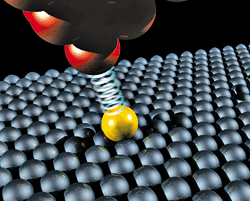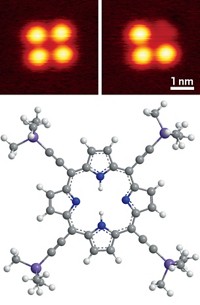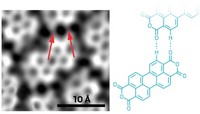Advertisement
Grab your lab coat. Let's get started
Welcome!
Welcome!
Create an account below to get 6 C&EN articles per month, receive newsletters and more - all free.
It seems this is your first time logging in online. Please enter the following information to continue.
As an ACS member you automatically get access to this site. All we need is few more details to create your reading experience.
Not you? Sign in with a different account.
Not you? Sign in with a different account.
ERROR 1
ERROR 1
ERROR 2
ERROR 2
ERROR 2
ERROR 2
ERROR 2
Password and Confirm password must match.
If you have an ACS member number, please enter it here so we can link this account to your membership. (optional)
ERROR 2
ACS values your privacy. By submitting your information, you are gaining access to C&EN and subscribing to our weekly newsletter. We use the information you provide to make your reading experience better, and we will never sell your data to third party members.
Physical Chemistry
Measuring Atomic Friction
Advances in atomic force microscopy allow scientists to measure single-atom forces on a surface
by Elizabeth K. Wilson
February 25, 2008
| A version of this story appeared in
Volume 86, Issue 8
FOR THE FIRST TIME, scientists have determined the forces needed to move a single atom across a surface. With this advance, it's now possible to quantify friction at the atomic level. Knowing how tightly an atom or a molecule "sticks" to a surface will be invaluable in nanoelectronics design and in bioengineering.
Using a modified atomic force microscope at ultrahigh vacuum and temperatures of only 5 K, a team of physicists measured both the lateral and vertical forces exerted on a cobalt atom or carbon monoxide molecule as the microscope tip dragged these diminutive particles along a platinum or copper surface (Science 2008, 319, 1066). The team included Andreas J. Heinrich and Markus Ternes at IBM's Almaden Research Center, in San Jose, Calif.; physics professor Franz Giessibl at the University of Regensburg, Germany; and their colleagues.
In 1990, the same IBM group, led by physicist Donald M. Eigler, first used a scanning tunneling microscope tip to spell "IBM" in xenon atoms on a nickel surface. Since then, numerous groups have succeeded in manipulating surface atoms. But measuring the forces involved has been difficult.
Being able to not only control microscope tip movement but also measure the forces associated with that movement is something "we all dreamed about," says Ludwig Bartels, chemistry professor at the University of California, Riverside. Bartels' studies have included coaxing atoms and molecules to "walk" and react on surfaces with a scanning tunneling microscope tip. "It is a milestone in understanding the mechanical behavior of matter at the single-atom scale," he says.

An AFM tip (red) measures the force it takes to move a cobalt atom (yellow) over a crystalline surface.
Scanning tunneling microscopy (STM) has the advantage of being able to move and resolve single atoms, but it doesn't impart information about the forces involved. So the IBM group turned to atomic force microscopy (AFM), a cousin of STM that senses surface atoms through a vibrating cantilever. The cantilever moves in response to forces between a single atom on its tip and the object it's scanning. Only recently has AFM achieved resolution at the atomic level.
Materials scientists who made such resolution possible for AFM include Oscar Custance at Japan's National Institute for Materials Science in Tsukuba, and Seizo Morita at Osaka University. In a perspective in Science accompanying the IBM report, these researchers note the new work "opens a new dimension in nanoscience that will bring exciting discoveries and technological achievements."
In addition to the proof-of-principle results, Heinrich's group noted some unexpected properties in different systems. For example, platinum appears to be a much "stickier" surface than copper, at least for cobalt. It requires 210 piconewtons of lateral force to move a cobalt atom on a platinum surface. In contrast, only 17 pN of force are needed to slide cobalt across a copper surface; that's comparable to the torque exerted by a bacterium's flagellar motor.

The group was also surprised to find that cobalt requires an order of magnitude greater lateral force to be dragged across a copper surface than a carbon monoxide molecule, even though both are relatively easy to move by STM.
Another curious effect, still unexplained, is that in the case of a metal atom on a metal surface, the lateral force appears to be independent of the vertical, or "loading," force: Even when the vertical force that attracts the atom to the microscope tip is increased, the lateral force needed to move the atom stays the same.
The force-measuring method can be applied to any molecule and to any surface, Heinrich says. "We want to get the message out—for others to pick up the ball and run with it."







Join the conversation
Contact the reporter
Submit a Letter to the Editor for publication
Engage with us on Twitter